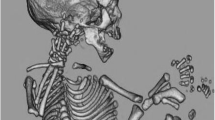Abstract
Background
Clinical use of 3D CT for fetal skeletal malformations is controversial.
Objective
The purpose of this study was to evaluate the efficacy of fetal 3D CT using three protocols with different radiation doses and through comparing findings between fetal CT and conventional postnatal radiographic skeletal survey.
Materials and methods
Seventeen fetuses underwent CT for suspected skeletal dysplasia. A relay of three CT protocols with stepwise dose-reduction were used over the study period. The concordance between the CT diagnosis and the final diagnosis was assessed. Ninety-three radiological findings identifiable on radiographs were compared with CT.
Results
Fetal CT provided the correct diagnosis in all 17 fetuses, the detectability rate of cardinal findings was 93.5 %. In 59 % of the fetuses an US-based diagnosis was changed prenatally due to CT findings. The estimated fetal radiation dose in the final protocol was 3.4 mSv (50 %) of the initial protocol, and this dose reduction did not result in degraded image quality.
Conclusion
The capability of fetal CT to delineate the skeleton was almost the same as that of postnatal skeletal survey. The perinatal management was altered due to these more specific CT findings, which aided in counseling and in the management of the pregnancy.






Similar content being viewed by others
References
Spranger J (2004) Introduction. In: Schumacher R, Seaver L, Spranger J (eds) Fetal radiology. Springer-Verlag, Berlin Heidelberg New York, p 1
Ruano R, Molho M, Roume J et al (2004) Prenatal diagnosis of fetal skeletal dysplasias by combining two-dimensional and three-dimensional ultrasound and intrauterine three-dimensional helical computer tomography. Ultrasound Obstet Gynecol 24:134–140
Cassart M, Massez A, Cos T et al (2007) Contribution of three dimensional computed tomography in the assessment of fetal skeletal dysplasia. Ultrasound Obstet Gynecol 29:537–543
Cassart M (2010) Suspected fetal skeletal malformations or bone diseases: how to explore. Pediatr Radiol 40:1046–1051
Boulet S, Althuser M, Nugues F et al (2009) Prenatal diagnosis of achondroplasia: new specific signs. Prenat Diagn 29:697–702
Slovis TL, Hall ET, Huda W et al (2002) ALARA conference executive summary. Pediatr Radiol 32:221
Miyazaki O, Nishimura G, Sago H et al (2007) Prenatal diagnosis of chondrodysplasia punctata tibia-metacarpal type using multidetector CT and three-dimensional reconstruction. Pediatr Radiol 37:1151–1154
Tsutsumi S, Sawai H, Nishimura G et al (2008) Prenatal diagnosis of thanatophoric dysplasia by 3-D helical computed tomography and genetic analysis. Fetal Diagn Ther 24:420–424
Yamada T, Nishimura G, Nishida K et al (2011) Prenatal diagnosis of short-rib polydactyly syndrome type 3 (Verma-Naumoff type) by three-dimensional tomography. J Obstet Gynaecol Res 37:151–155
Shoda S, Hamada H, Oki A et al (1997) Diagnosis of fetal anomalies by three-dimensional imaging using helical computed tomography. Prenat Diagn 17:670–674
Bonnefoy O, Delbosc JM, Maugey-Laulom B et al (2006) Prenatal diagnosis of hypochondroplasia: three-dimensional multislice computed tomography findings and molecular analysis. Fetal Diagn Ther 21:18–21
Felmlee JP, Gray JE, Leetzow ML et al (1990) Estimated fetal radiation dose from multislice CT studies. AJR 154:185–190
Sasaki A, Hayashi S, Oi R et al (2011) A fetus diagnosed with Casamassima-Morton-Nance syndrome with de novo del(8)(p23.1). Prenat Diagn 31:407–409
Doray B, Favre R, Viville B et al (2000) Prenatal sonographic diagnosis of skeletal dysplasia. A report of 47 cases. Ann Genet 43:163–169
Parilla BV, Leeth EA, Kambich MP et al (2003) Antenatal detection of skeletal dysplasias. J Ultrasound Med 22:255–258
Guillerman RP (2011) Newer CT applications and their alternatives: what is appropriate in children? Pediatr Radiol 41:s534–S548
ICRP (2000) Annals of the ICRP publication 84, 30(1). Elsevier Science Ltd, London
Donadieu J, Zeghnoun A, Roudier C et al (2006) Cumulative effective doses delivered by radiographs to preterm infants in a neonatal intensive care unit. Pediatrics 117:882–888
Fujii K, Akahane K, Miyazaki O et al (2011) Evaluation of organ doses in CT examinations with an infant anthropomorphic phantom. Radiat Prot Dosim 147(1-2):151–155
Hurwitz LM, Yoshizumi T, Reiman RE et al (2005) Radiation dose to the fetus from body MDCT during early gestation. AJR 186:871–876
Garjian KV, Pretorius DH, Budorick NE et al (2000) Fetal skeletal dysplasia: three-dimensional US-initial experience. Radiology 21:717–723
Krakow D, Williams J, Poehl M (2003) Use of three-dimensional ultrasound imaging in the diagnosis of prenatal-onset skeletal dysplasias. Ultrasound Obstet Gynecol 21:467–472
Acknowledgments
This article was supported by a grant for scientific research from the Ministry of Health, Labour and Welfare of Japan, H23-Nanchi-Ippan-123.
We thank CT technologists Fumie Okazaki, Ayano Shimada and Hiroshi Nagamatsu. We would like to thank pediatric radiologists at the National Center for Child Health and Development, Drs. Shunsuke Nosaka, Yoshiyuki Tsutsumi, Mikiko Miyasaka, and Reiko Okamoto.
Author information
Authors and Affiliations
Corresponding author
Rights and permissions
About this article
Cite this article
Miyazaki, O., Nishimura, G., Sago, H. et al. Prenatal diagnosis of fetal skeletal dysplasia with 3D CT. Pediatr Radiol 42, 842–852 (2012). https://doi.org/10.1007/s00247-012-2381-7
Received:
Revised:
Accepted:
Published:
Issue Date:
DOI: https://doi.org/10.1007/s00247-012-2381-7




